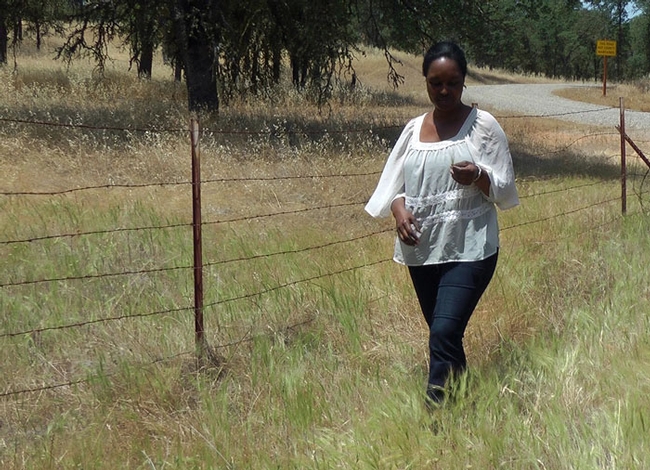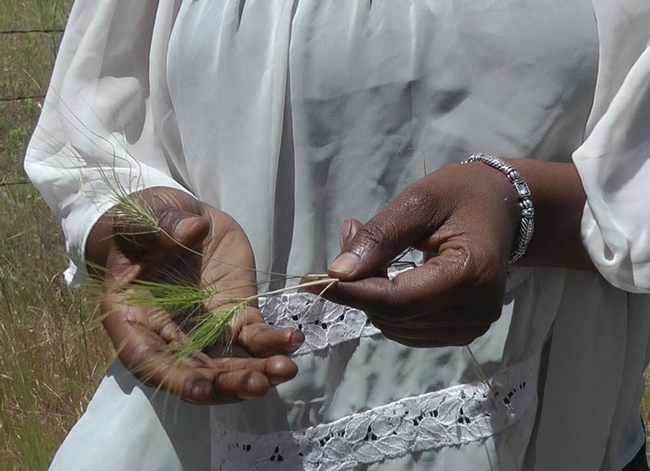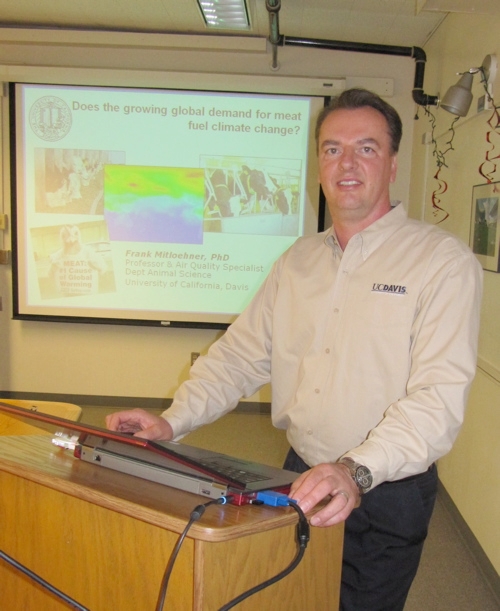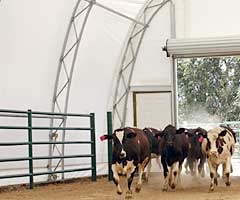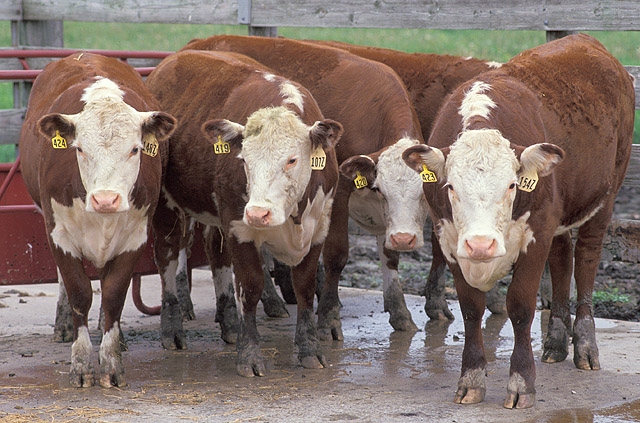Posts Tagged: livestock
Ranchers concerned about invasion of medusahead weed on foothill rangeland
One of the worst rangeland weeds in the West is aptly named after a monster in Greek mythology that has writhing snakes instead of hair.
Medusahead, an unwelcome transplant from Europe, is anathema to the cattle living off rangeland grass. The weed's three-inch-long bristles poke and sometimes injure the animals' mouths and eyes. The weed is also low-quality forage for livestock. When medusahead takes over rangeland, it reduces the forage value by 80 percent.
When Fadzayi Mashiri, UC Cooperative Extension advisor in Mariposa, Merced and Madera counties, was appointed in 2013, she became the first natural resources and rangeland expert to hold the position since the retirement of Wain Johnson more than a decade before. She polled local ranchers to determine their most pressing problems. They said weed management, and in particular, medusahead.
Medusahead is relatively easy to identify on the range. It has distinctive stiff awns and a seed head that does not break apart as seeds mature. Patches of medusahead are obvious when spring turns into summer.
“Medusahead stays green after most of the annual grasses have dried off,” Mashiri said.
Medusahead has high silica content, making it unpalatable to cattle. The silica also protects the plant from decomposition, so a thick thatch builds up on the rangeland, suppressing more desirable species, but not the germination of the next year's medusahead seedlings.
Over the years, UC scientists have discovered a number of medusahead control strategies:
- Corral cows on medusahead before the plant heads out or employ sheep to graze medusahead patches. It's not sheep's favorite forage either, but they will eat if left with no other option.
- Prescribed burning in late spring or early summer. However, this strategy poses air quality and liability issues.
- Apply nitrogen fertilizer to medusahead to improve palatability before it flowers, which is showing promise for controlling the weed and boosting the value of infested rangeland.
- Chemical control.
In spring 2014, Mashiri conducted a demonstration field trial in Mariposa County of medusahead control with the herbicide Milestone, which was developed by Dow AgroSciences mainly to control broadleaf weeds like yellow starthistle. The trial followed rangeland weed control research done by scientists including Joe DiTomaso, UC Cooperative Extension specialist in the Department of Plant Sciences at UC Davis. DiTamaso found that the density of medusahead in treated areas declined and concluded that Milestone prevents medusahead seedlings from thriving.
Unfortunately, Milestone treatment of large rangeland areas is expensive.
“But if the value of forage declines, the productivity of livestock is compromised,” Mashiri said. “When you look at it that way, the chemical treatment might be useful.”
Is livestock’s contribution to climate change still being overestimated?
In a 1,000 year old village in Germany (Juehnde), methane is not a dirty word. The recovered methane from a manure-fueled bioreactor feeds the burners that heat water for every household in the village. The same hot water provides heating. These households benefit from living adjacent to a livestock economy whose manure was once just a smelly nuisance. The manure is transported by truck to an enclosed bioreactor, thereby reducing odor and feeding a system that powers an entire community. Frank Mitloehner once called this village home. Now a professor and air quality UC Cooperative Extension specialist in the Department of Animal Science at UC Davis, Mitloehner thinks that if this village can do it, so can California.
It is easy to see how Mitloehner was inspired to study ways that California can take advantage of its plentiful supplies of animal methane. In eight bovine bio-bubbles that function as airtight barns, he captures and measures every emission from his resident livestock in order to understand how methane emissions vary with feed and herd management.
At Davis, a commercialized version of a similar methane bio-reactor has been patented and licensed by Ruihong Zhang, professor in the Department of Biological and Agricultural Engineering at UC Davis. It has been constructed at the local landfill and will be used to demonstrate a sustainable village on the UC Davis campus.
Mitloehner recently hosted a seminar for the Western Center for Agricultural Health and Safety at Davis. Since the Food and Agriculture Organization of the United Nations (FAO) committee released their 2006 report entitled, “Livestock’s Long Shadow,” he has challenged two key misleading sentences in their report. The phrase compared the contribution of livestock emissions to that of transportation. By saying the contributions to climate change were similar, the report led many environmental advocates to the conclusion that eating less meat was the equivalent of taking cars off the road, setting up a meat vs. miles tradeoff that exaggerated the methane contributions of livestock everywhere.
Mitloehner’s response was the publication Clearing the Air, Livestock’s Contribution to Climate Change. After his paper was released, BBC, CNN and other media published his science-based estimate that the livestock contribution in the U.S. is 3.4 percent of U.S. emissions. Globally, 18 percent of warming was estimated to be livestock related. This estimate included livestock in the broadest sense - changes in land use, deforestation and desertification in developing countries.
In spite of Mitloehner’s paper, the meat vs. miles perception has persisted among advocates, while press about transportation GHG has dwindled. Toyota took advantage in their advertising by showing how Prius emissions were more favorable than those of a sheep.
Nonetheless, Mitloehner showed that U.S. methane emissions remain flat, while developing countries are increasing animal production to meet the demand for eggs, meat and dairy, especially Asia. But why is the U.S. so low?
Mitloehner shared a few facts that help explain the phenomena:
- The U.S. has fewer dairy cows. Today’s 9 million dairy cows supply 60 percent more milk than the 16 million cows in production in 1950. That means there is increased efficiency per cow for the same methane produced.
- Thirty percent of the methane in dairy production is from manure in ponds. There is the potential for recovery on the approximately 1,500 California farms, where the average herd size is 1,100 head.
- Methane has 20 times the warming potential of carbon dioxide, but when burned to heat water or to generate power, its warming potential is reduced by a factor of 20.
- The more fiber in the feed, the more methane is released by the rumen of the animal. One dairy cow in the U.S. produces an average of 20,000 lbs of milk per cow annually, the same amount of milk as five cows in Mexico, or up to 100 cows in India for the same, or less methane per cow. Reasons: low fiber diet, less parasites and less disease result in large differences in production per cow.
Mitloehner occupies that middle space between the economically driven farmers who survived years of falling milk prices and the sustainable advocates that want dairy to either disappear entirely or retreat into historical practices. When he is not serving on the President’s Council of Advisors on Science and Technology (PCAST) or the National Academies Institute of Medicine, he keeps company with local farmers and students and answers to science.
Dairy addicts like myself, whose ancestors have evolved on milk for over 10,000 years, are likely to continue to frequent the organic dairy cases, hopeful that there are mutual benefits to paying higher prices for local labels in returnable glass bottles as a way to sustain the farms.
In reality, California has been exporting surplus dairy products to growing populations since the 1890s and that won’t change soon. Those markets do more to keep dairies profitable than my weekly milk and yogurt purchase. Lactose for pharmaceuticals and whey proteins for infant formulas are shipped internationally from several of California’s mammoth cheese factories, sometimes worth more the cheese itself.
Mitloehner believes that “sustainable intensification” is the solution to keeping local dairies viable. He believes that science will provide the path to better regulation. The dairy nations that seem determined to get at the truth - New Zealand, France, Ireland and the Netherlands - have formed an international partnership at FAO entitled LEAP to address the issues. Mitloehner's leadership a chair of the partnership will keep methane bioreactors on the agenda.
More information:
Mitloehner tells the story of how he neutralized errors in the FAO report “Livestock’s Long Shadow” (YOUtube).
LEAP site at the FAO. NGOs include World Wildlife Federation and Greenpeace. Mitloehner said that Greenpeace is also a partner although not listed on the site. Workshop materials available for download.
July 2012 opinion post by Robert Goodland at New York Times food blog. This is an example of criticism of Mitloehner’s role as head of the FAO partnership LEAP (Livestock Environmental Assessment and Performance).
Docs ask: Does “do no harm” apply to food served in hospitals?
“First, do no harm” is a core tenet taught to aspiring medical professionals. In June this year, the Sustainability Task Force of the UCSF Academic Senate drafted a resolution asking UCSF food services to phase out of all procurement of meat produced with the use of non-therapeutic antibiotics. Given that many scientists believe that the use of prophylactic antibiotics for livestock production causes antibiotic resistance, how can physicians stand by while hospitals serve foods from antibiotic-treated animals to patients that increasingly suffer from antibiotic-resistant infections? If not, what can they do about it?
In a few weeks, local organizations will take up the hard questions again with their peers at UCSF Medical Center. Going beyond meatless Mondays, healthcare professionals, Healthcare Without Harm, and PEW Charitable Trusts, all see antibiotic-free meat and poultry as the next step in advocating for healthier food.
Fixing this problem for most of us is as simple as buying organic meat or free-range antibiotic-free alternatives. For a UC medical center, however, it is far from simple. Price, supply and food budgets are all based on past purchase history. It takes considerable will, consensus, and commitment to “do no harm” before administrators will agree to pay double or triple the cost for meat produced without these drugs. Cattle fed regular antibiotics to fatten them up, even when they are healthy, are more profitable up the entire food chain.
The advocates for the healthcare side want to know: Can this become a priority for us and our hospitals? Where are the suppliers of antibiotic-free products? Are they selling the cuts we need? How can change be “phased in” to allow the distribution chain to supply this emerging demand? In a hospital, should food be one of the least expensive of many pricey services?
The producers are likely to have questions, too. Is this a lucrative opportunity for smaller alternative suppliers, or is it a political battle to force big agriculture to comply? If producers start down this road, how many bumps will they encounter along the way? Why should they risk supplying a new market when business is risky as is? How long will they commit to these products?
It seems logical that low production costs alone should not threaten the public health of a nation or even just the health of the nation's vulnerable citizens. If these drugs were never allowed for feeding in the first place, producers would be on a level playing field and beef might be more than a commodity. Likewise, ethical food standards have defined humanity for thousands of years. So now that there is more food, more technology and more choice, why is it more difficult to make changes that ultimately benefit everyone?
More information:
The Sustainability Committee of the UC San Francisco Division of UC Academic Senate June 2013 resolution includes a link to a bibliography.
Health Care Without Harm is an international coalition of 500 organizations in 53 countries working to transform the health care sector, without compromising patient safety or care, so that it is ecologically sustainable and no longer a source of harm to public health and the environment.
San Francisco Bay Area Physicians for Social Responsibility, Healthy Food in Health Care Program. 510-559-8777
Photo by Keith Weller, USDA, ARS, Photo Library
California's dry winter is leaving west side cattle hungry
The long rainless winter resulted in grass growth on the west side of the San Joaquin Valley about 80 percent less than usual, reported John Holland in the Modesto Bee. Spring rain pushed somewhat more growth on the valley's east side, which was charted at 55 to 70 percent less than normal.
Theresa Becchetti, UC Cooperative Extension advisor in Stanislaus and San Joaquin counties, a livestock expert, and Diana Waller, district conservationist for the U.S. Natural Resources Conservation Service, reported the conditions in a letter last month to county and federal agriculture officials.
Fall 2011 rain helped germinate seeds, but "unfortunately, that is where it ended," they wrote.
A cattle producer quoted in the story said the poor feed conditions are offset somewhat by beef prices that have remained strong.
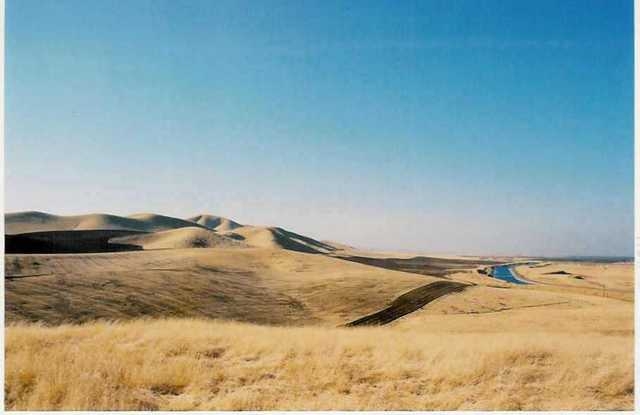
The USDA reported that nonirrigated range condition was poor to fair, with some higher-elevation range in good to fair condition.
Not a lot of greenhouse gas is from animal ag
There's been some confusion in recent years about the impact of animal agriculture on global warming. UC Davis Cooperative Extension air quality specialist Frank Mitloehner will share his findings on the subject this month during a free webinar on the eXtension website, according to an article in Pork magazine.
The 2006 United Nations report "Livestock's Long Shadow" said the livestock sector is responsible for 18 percent of greenhouse gas emissions, a higher share than transportation. Mitloehner said livestock's contribution is more like 3 percent, yet wide distribution of the misinformation has put Americans and others on the wrong path toward solutions.
The webinar, which will include information from Mithoehner's report "Clearing the Air: Livestock's Contribution to Climate Change," is at 11:30 a.m. Pacific Time June 11. Forum participants will have the opportunity to ask questions, post comments, upload photos and share their experiences. All the details, including links to background information and to the webinar, are in this eXtension flyer.
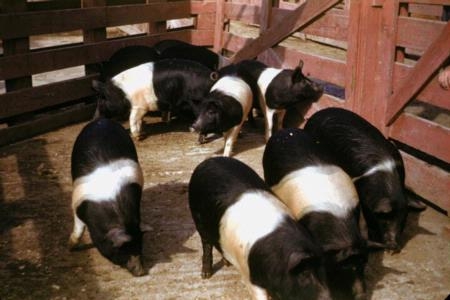
Black and white swine.


